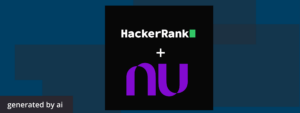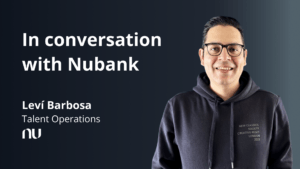
Companies count on data-driven insights from recruitment analytics to navigate the ever-changing talent landscape. To really make a difference, those leading talent analytics need to assess how well their efforts are working, find ways to improve, show their value, and reinforce the need for ongoing investment.
So, to get a better understanding of how it’s done and learn the key components of it, we had a conversation with Leví Barbosa, Talent Operations at Nubank, to discuss how they’re leading this change.
Nubank is one of the world’s largest digital financial services platforms. Its central operations hub is stationed in Brazil. Additionally, the company maintains offices or technology hubs in five countries: Mexico, Colombia, Uruguay, United States and Germany. Moreover, when it comes to talent data and analytics, Nubank is ahead of the game. They’ve developed various internal metrics and tools that help optimize hiring processes, enhance candidate and interviewer experience, and become a base for all talent-related decisions.

What are some key metrics or indicators that you’re using today to evaluate the success of your hiring strategy?
We utilize internal tools to gauge universal metrics such as time-to-fill and cost-per-hire. Moreover, we’ve established a standard for measuring quality, which forms the foundation for evaluating the quality of hires. Our focus also extends to enhancing the candidate experience, particularly during the interview process.
How is Nubank measuring hard-to-measure metrics such as candidate experience and inclusion?
Regarding candidate experience, our approach involves assessing “candidate freshness.” We track the duration candidates spend in specific stages of the recruitment process compared to stages without any activity. This leads to categorizing candidates as green, yellow, or red, encouraging our teams to maintain candidates in the green category. This method helps us identify engaged candidates and provides room for enhancing their experience through active communication. Additionally, we’ve introduced coordinators who engage with candidates, hiring managers, interviewers, recruiters, and possess comprehensive knowledge of the entire process.
Can you provide examples of specific data points or sources that can be leveraged to analyze hiring effectiveness?
We’ve developed an extensive skill catalog for each of these positions.
HackerRank has been instrumental, as its readily available skill catalog has been customized to our needs. For instance, when hiring for roles like analytics engineers, we often tap into this catalog and even consider internal candidates when external hires are challenging. This skill mapping initiative from the previous year has significantly improved our hiring practices. In essence, we’re constructing a skills ontology for the entire organization and utilizing skills-related data and analytics to guide our hiring decisions.
How do you use data and analytics personally in your role?
Currently, one crucial aspect of our analytics focus is on interviews. Before the interview stage, we utilize an internal system that assists us not only in understanding the volume of interviews but also in capacity planning for schedulers and interviewers. We analyze data to determine peak interview times during the day, broken down by department. This helps us optimize team activities, ensuring that certain tasks are carried out during the most productive hours. We also track the time candidates spend in different interview stages, comparing internal efficiency to the time taken by the business. This analysis guides our communication strategies with candidates, explaining potential delays and setting appropriate expectations. We also often tell candidates “hey, we’re busy and might need additional time”, but keeping conversations transparent helps in managing expectations from both organizational and individual perspectives. However, the crucial part is that now we have the intelligence to say “here’s where you’re the most productive” and guide the teams on how to prioritize.
How has HackerRank helped you to streamline your hiring process and identify top candidates more efficiently?
HackerRank has proven invaluable beyond simple test results.
The capability to create live cases and the range of features have empowered our engineering team. They can even schedule their own interviews, enhancing efficiency. This tool is particularly beneficial for high-volume hirings, saving time and resources compared to developing custom internal tools.
What metrics are you using to measure the success of your HackerRank-powered hiring initiatives, and what results have you seen so far?
With HackerRank, we’re already equipped with nearly everything we need. Internally, the only focus is on developing more localized questions because our headquarters are in Brazil, where many interviews take place. But besides that, having the results available on the HackerRank platform is proving advantageous. It’s not only facilitating quicker decision-making but also providing deeper insights into candidate quality, allowing us to better understand the caliber of candidates we’re considering.
Has HackerRank provided any benefits that you did not anticipate?
Yes, indeed. GPT raised concerns initially. Many individuals worried about the possibility of candidates using AI to generate correct responses, prompting questions about prevention methods.
HackerRank responded rapidly by implementing AI-driven solutions to detect such instances. This went beyond just the AI feature itself, extending to additional functionality that identifies tab switching and potential copy-paste answers. This unexpected feature has proven quite valuable. For example, we encountered challenges with our internship program, but recent discussions with the HackerRank team have yielded valuable results. We’re now able to modify tests to address these detection challenges more effectively, enhancing our overall assessment process. This has the potential to identify individuals who might be using unauthorized tools.
It’s worth noting that in the era of AI’s increasing prominence across industries, maintaining assessment integrity is crucial. This additional feature helps ensure the authenticity of candidates’ efforts and results, promoting a fair evaluation process.
What are some effective ways to use data analysis to identify and reduce time-to-hire and cost-per-hire? Can you share examples of how Nubank has successfully optimized their hiring strategies using data and analytics?
Certainly. Time to fill offers an overarching view of a particular position’s recruitment journey. However, focusing on time in the stage allows us to pinpoint specific stages that might have posed challenges. This analysis can help us discern whether difficulties stemmed from candidate availability, internal team processes, or business-related factors.
By examining these three dimensions, we gain a more comprehensive understanding of time-related aspects—not only concerning the recruitment process but also regarding the subsequent impact on the quality of the hire.
What advice would you give to other companies looking to improve their technology hiring process?
This year has brought about a significant shift in many companies, almost like a 180-degree change. In numerous organizations, there’s been a noticeable trend towards adopting extensive and costly technology stacks within their talent acquisition departments.
From discussions with colleagues in other companies, it’s evident that these technology stacks have grown substantially. They often comprise not only Applicant Tracking Systems (ATSs) but also an array of additional tools. However, this abundance of tools sometimes results in their underutilization due to time constraints. Consequently, while they may possess several tools, they typically only rely on one or two, rendering the others redundant.
Would you like to add anything about the growing need of analytics in the talent and people functions?
I’d like to underscore the crucial role of data analytics in this context. Having spent a decade focused on data analytics in talent acquisition, I recognize its immense value. The DIKW (Data-Information-Knowledge-Wisdom) pyramid serves as an effective framework. It outlines the progression from raw data to actionable wisdom. Someone dedicated to bridging this gap is essential, as not everyone possesses the technical skills required to transform data into meaningful insights, particularly in talent acquisition. Consequently, having an expert who can facilitate the transformation from data to knowledge is vital, especially now.
Furthermore, analytics in talent acquisition has evolved beyond basic descriptive analysis. We’ve ventured into diagnostic, predictive, and even prescriptive analytics. The incorporation of tools like ChatGPT showcases the potential to revolutionize analytics. It’s important for organizations to recognize the value of having dedicated talent acquisition analytics professionals who can harness data for strategic decision-making.
